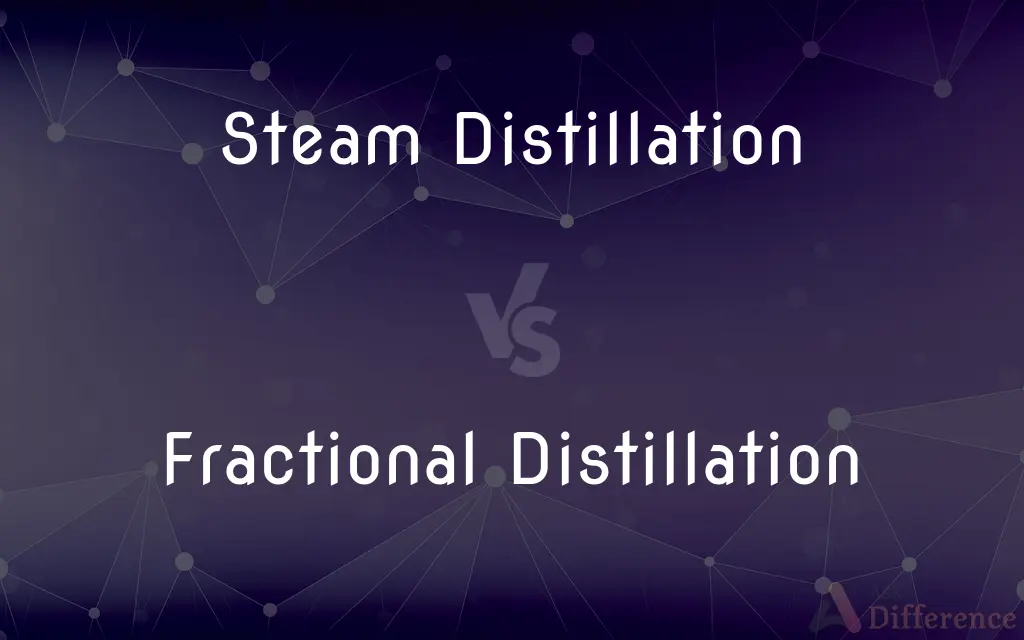Steam Distillation vs. Fractional Distillation — What's the Difference?
By Tayyaba Rehman — Published on November 9, 2023
Steam Distillation uses steam to separate substances based on volatility, commonly for essential oils. Fractional Distillation separates mixtures into fractions based on boiling points.

Difference Between Steam Distillation and Fractional Distillation
Table of Contents
ADVERTISEMENT
Key Differences
Steam Distillation is a specialized distillation method that employs steam to separate certain substances from a mixture. In this process, both steam and the mixture are heated together. The goal of Steam Distillation is to extract compounds, like essential oils, without damaging them due to high temperatures. The vapor produced contains both water and the volatile components, which are then condensed to yield the desired product.
Fractional Distillation, on the other hand, involves the separation of a mixture into its individual components or fractions based on their distinct boiling points. A fractionating column is used, which allows multiple vaporization-condensation cycles. As vapors ascend the column, they cool, condense, and revaporize, with each cycle leading to a purer substance. Fractional Distillation is vital for refining petroleum into gasoline, diesel, and other products.
Comparing Steam Distillation and Fractional Distillation highlights their unique uses and mechanisms. While Steam Distillation is ideal for temperature-sensitive compounds, especially in botanical extracts like essential oils, Fractional Distillation is more geared towards separating compounds with close boiling points, ensuring high purity levels in the resulting fractions.
Another distinction lies in the apparatus used. Steam Distillation setups typically have a steam source, a distillation flask for the mixture, and a condenser. In contrast, Fractional Distillation setups are equipped with a fractionating column filled with packing material to increase surface area and improve separation efficiency.
In conclusion, both Steam Distillation and Fractional Distillation are indispensable techniques in chemistry and industry. While they both involve the conversion of a liquid to vapor and then back to liquid, their applications, methods, and setups make them distinct from each other.
ADVERTISEMENT
Comparison Chart
Purpose
Extract temperature-sensitive compounds.
Separate mixtures based on boiling points.
Application
Essential oils, botanical extracts.
Petroleum refining, separating close boiling point compounds.
Temperature Sensitivity
Ideal for substances sensitive to high temperatures.
Can handle higher temperatures.
Apparatus
Steam source, distillation flask, condenser.
Fractionating column, heat source, condenser.
Mechanism
Uses steam to vaporize compounds.
Uses a fractionating column for multiple vaporization-condensation cycles.
Compare with Definitions
Steam Distillation
Separation based on volatility with steam.
The combination of water and plant material in Steam Distillation yields aromatic compounds.
Fractional Distillation
Suitable for mixtures with close boiling points.
To obtain pure ethanol from an aqueous solution, Fractional Distillation is utilized.
Steam Distillation
Extracts compounds without high temperature damage.
Lavender oil is obtained using Steam Distillation to maintain its therapeutic properties.
Fractional Distillation
Multiple vaporization-condensation cycles for purity.
The repeated cycles in Fractional Distillation ensure high purity levels.
Steam Distillation
A distillation method employing steam.
Steam Distillation is commonly used for extracting essential oils.
Fractional Distillation
Separates mixtures into fractions using boiling points.
Fractional Distillation efficiently divides crude oil into various fuels.
Steam Distillation
Produces vapor containing water and volatile components.
In Steam Distillation, the condensed vapor provides a mix of water and the desired compound.
Fractional Distillation
Uses a fractionating column for separation.
The column in Fractional Distillation allows better separation of compounds.
Steam Distillation
Used for temperature-sensitive substances.
To avoid degrading certain botanicals, Steam Distillation is preferred.
Fractional Distillation
Common in refining and chemical industries.
Fractional Distillation plays a pivotal role in producing various petrochemicals.
Common Curiosities
Why use steam in Steam Distillation?
Steam helps vaporize the desired compounds without reaching high temperatures that might degrade them.
How does Fractional Distillation work?
Fractional Distillation separates mixtures based on their boiling points using a fractionating column.
Can Steam Distillation handle high temperatures?
Steam Distillation is best for temperature-sensitive compounds, avoiding high temperature degradation.
Which method ensures higher purity for close boiling point compounds?
Fractional Distillation is more suited for separating compounds with close boiling points.
Are essential oils extracted using Fractional Distillation?
Essential oils are typically extracted using Steam Distillation due to their temperature sensitivity.
What's the role of the fractionating column in Fractional Distillation?
The column allows multiple vaporization-condensation cycles for improved separation and purity.
What is Steam Distillation?
Steam Distillation uses steam to separate substances, often extracting essential oils from plants.
Where is Fractional Distillation commonly applied?
It's widely used in petroleum refining and in separating compounds with close boiling points.
Can Steam Distillation separate compounds based on boiling points?
Steam Distillation focuses on volatility in the presence of steam, not strictly on boiling points.
Which method uses multiple vaporization-condensation cycles?
Fractional Distillation involves repeated vaporization-condensation cycles for enhanced separation.
Why is steam not used in Fractional Distillation?
Fractional Distillation relies on boiling point differences, not on steam-induced volatility.
Can both methods be used in the food industry?
While Steam Distillation is used for flavorings and essential oils, Fractional Distillation can purify alcoholic beverages.
Is Steam Distillation limited to botanical extracts?
While common for botanicals, Steam Distillation can be used for other temperature-sensitive compounds too.
Do both methods produce pure products?
Both aim for purity, but Fractional Distillation, with its fractionating column, often achieves higher purity levels for close boiling point mixtures.
Which apparatus is unique to Fractional Distillation?
The fractionating column is a distinctive apparatus in Fractional Distillation.
Share Your Discovery

Previous Comparison
Delhi vs. New DelhiAuthor Spotlight
Written by
Tayyaba RehmanTayyaba Rehman is a distinguished writer, currently serving as a primary contributor to askdifference.com. As a researcher in semantics and etymology, Tayyaba's passion for the complexity of languages and their distinctions has found a perfect home on the platform. Tayyaba delves into the intricacies of language, distinguishing between commonly confused words and phrases, thereby providing clarity for readers worldwide.

















































